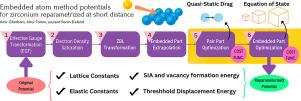嵌入原子法在近距离重新参数化Zr势
IF 1.4
3区 物理与天体物理
Q3 INSTRUMENTS & INSTRUMENTATION
Nuclear Instruments & Methods in Physics Research Section B-beam Interactions With Materials and Atoms
Pub Date : 2025-09-10
DOI:10.1016/j.nimb.2025.165843
引用次数: 0
摘要
对三个嵌入原子法(EAM)原子间势进行了重新参数化,以提高它们描述辐照下Zr中初级损伤产生的能力。为了在保持材料的近平衡性质不变的情况下,改善对Zr原子在近距离和高压下的描述,对这些EAM势的二体和嵌入能量函数进行了修正。重新参数化是通过密度泛函理论计算得到的。即,计算Zr的状态方程和嵌入二聚体的能量(也称为施加准静态阻力)并将其作为拟合的目标。与原始EAM势相比,重新参数化的势具有相似的点缺陷形成能和弹性常数。另一方面,重参数化对位移阈值能(tde)有显著影响。特别是,重新参数化使得所有三个EAM电位预测的0001 TDE更接近先前报道的从头算TDE值。本文章由计算机程序翻译,如有差异,请以英文原文为准。

Embedded atom method potentials for Zr reparameterized at short distance
Three embedded atom method (EAM) interatomic potentials were reparameterized to improve their ability to describe primary damage production in Zr under irradiation. Both the two-body and embedding energy functions of these EAM potentials were refitted with the goal of improving the description of Zr atoms at short distance and under high pressure, while keeping the near-equilibrium properties of the material unchanged. The reparameterization was informed by density functional theory calculations. Namely, the equation of state of Zr and the energy of embedded dimers (also known as applying quasi-static drag) were calculated and used as targets for the fit. The reparameterized potentials have similar point defect formation energies and elastic constants as compared to the original EAM potentials. On the other hand, reparameterization had a significant impact on displacement threshold energies (TDEs). In particular, reparameterization led the TDE as predicted by all three EAM potentials to become much closer to a previously reported ab initio TDE value.
求助全文
通过发布文献求助,成功后即可免费获取论文全文。
去求助
来源期刊
CiteScore
2.80
自引率
7.70%
发文量
231
审稿时长
1.9 months
期刊介绍:
Section B of Nuclear Instruments and Methods in Physics Research covers all aspects of the interaction of energetic beams with atoms, molecules and aggregate forms of matter. This includes ion beam analysis and ion beam modification of materials as well as basic data of importance for these studies. Topics of general interest include: atomic collisions in solids, particle channelling, all aspects of collision cascades, the modification of materials by energetic beams, ion implantation, irradiation - induced changes in materials, the physics and chemistry of beam interactions and the analysis of materials by all forms of energetic radiation. Modification by ion, laser and electron beams for the study of electronic materials, metals, ceramics, insulators, polymers and other important and new materials systems are included. Related studies, such as the application of ion beam analysis to biological, archaeological and geological samples as well as applications to solve problems in planetary science are also welcome. Energetic beams of interest include atomic and molecular ions, neutrons, positrons and muons, plasmas directed at surfaces, electron and photon beams, including laser treated surfaces and studies of solids by photon radiation from rotating anodes, synchrotrons, etc. In addition, the interaction between various forms of radiation and radiation-induced deposition processes are relevant.

 求助内容:
求助内容: 应助结果提醒方式:
应助结果提醒方式:


